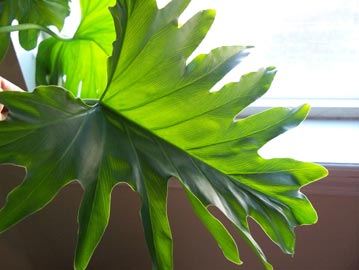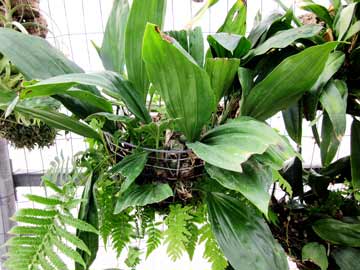 Healthy houseplants have flawless green leaves.
Healthy houseplants have flawless green leaves.
Jodi Torpey
While houseplants can’t talk, they can send signals when they’re getting too much or not enough care. Instead of healthy green leaves, they communicate with yellow leaves, brown leaf tips, or wilted foliage.
Because many indoor plants originated in the tropics, they have specific environmental needs. Ferns, palms, philodendron and many other houseplants prefer warm, humid temperatures, bright sunlight and rich, evenly moist soil. However, most houseplants experience the opposite: fluctuating temperatures, dry air, low light levels and inconsistent watering.
Houseplants can get sick if they receive too much or not enough of what they need. Indoor gardeners can cure their houseplant ills by watching for these common symptoms and then taking the correct action:
 Browning leaf tips and spots are two signs this plant needs help.
Browning leaf tips and spots are two signs this plant needs help.
Jodi Torpey
Browning leaf tips and spots on leaves are typically caused by overwatering, overheating and low humidity. Check soil moisture on a regular basis, but wait to water until the first several inches of soil are dry. Keep plants away from hot air vents, fireplaces and radiators. Increase the amount of water moisture in the air by placing plant containers together on trays of moist pebbles.
Yellowing leaves that fall can result from overwatering, but also cold drafts and fluctuating indoor temperatures. Keep plants away from entry doors and cold window sills. Houseplants can suffer when temperatures dip below 60 degrees at night.
Drooping, then dropping, leaves are a symptom of sickly roots due to overwatering and poor soil drainage. Allow the soil to dry before adding any more water and make sure water easily drains.
Wilting before lower leaves yellow and drop is a sign of too much fertilizer, especially if there is crusting on top of the soil. Because houseplants slow their growth in winter, refrain from fertilizing until spring. When plants start growing again, begin fertilizing with an all-purpose plant food and apply every 4 to 6 weeks during the growing season.
Wilting between waterings occurs because potting soil is too dry. If the plant bounces back after watering, keep soil evenly moist (not soggy) to prevent future wilting. Discard any excess water that drains into the saucer.
Burning, scorching or severe wilting happens when plants get too much sunlight from a south or west facing window. Move plants so they receive indirect or filtered sunlight.
Blooming houseplants that fail to flower or plants that get long and leggy stems need more light. African violets, begonias and fuchsias can benefit from supplemental or artificial lighting. Place fluorescent bulbs or grow lights about 12 inches above plants and give them up to 16 hours of light each day.
By Jodi Torpey, garden writer and author